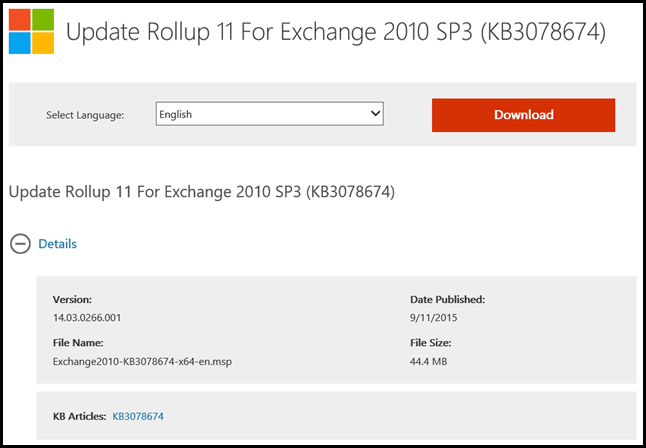The Exchange team today announced the availability of Update Rollup 11 for Exchange Server 2010 Service Pack 3. RU11 is the latest rollup of customer fixes available for Exchange Server 2010. The release contains fixes for customer reported issues and previously released security bulletins.
This is build 14.03.0266.001 of Exchange 2010, and KB3078674 has the full details for the release. The update file name is Exchange2010-KB3078674-x64-en.msp.
Note that this is only for the Service Pack 3 branch of Exchange 2010. Why? Exchange 2010 SP2 exited out of support on the 8th of April 2014and will no longer receive updates. Customer must be on Exchange 2010 SP3 to receive updates.
For those looking at deploying Exchange 2016, RU11 will be important. Rollup 11 is the minimum version of Exchange Server 2010 which will co-exist with Exchange Server 2016.
Also note that Exchange 2010 transitioned into its Extended product support lifecycle phase on the 13th of January 2015. Exchange 2010 will now be serviced as per the extended support policy.
Issues Resolved
-
KB 3092576 Exchange 2010 Information Store crashes randomly
Important Notes
Now, before we rush off to download and install this there are a couple of items to mention!
-
Test the update in your lab before installing in production. If in doubt test…
-
Ensure that you consult with all 3rd party vendors which exist as part of your messaging environment. This includes archive, mobility and management services.
-
Ensure that you do not forget to install updates on management servers, jump servers/workstations and application servers where the management tools were installed for an application. FIM and 3rd party user provisioning solutions are examples of the latter.
-
If the Exchange server does not have Internet connectivity then this introduces significant delay in building the Native images for the .Net assemblies as the server is unable to get to http://crl.microsoft.com. To resolve this issue, follow these steps:
-
On the Tools menu in Windows Internet Explorer, click Internet Options, and then click the Advanced tab.
-
In the Security section, click to clear the Check for publisher's certificate revocation check box, and then click OK.
We recommend that you clear this security option in Internet Explorer only if the computer is in a tightly controlled environment. When setup is complete, click to select the Check for publisher’s certificate revocation check box again.
-
- Install the update from an elevated command prompt
- Update Internet facing CAS servers first
-
Backup any OWA customisations as they will be removed
-
Uninstall any Interim Updates (IUs) before installing he RU. You will have received these private files directly from Microsoft.
-
Disable file system antivirus prior to installing the RU.
-
Restart server after RU has been installed and then re-enable file system antivirus
-
Test (yes, technically this is in here for a second time but it is very important!)
Cheers,
Rhoderick
